Critical Reflection: Drain Removal Experience in Nursing Practice
VerifiedAdded on 2022/10/18
|6
|1478
|16
Report
AI Summary
This report presents a critical reflection on a nursing student's first experience with drain removal, utilizing the Gibbs Reflective Cycle. The student describes the procedure, including pre- and post-operative steps, and details their feelings of nervousness and challenges encountered during the practical assessment. The self-evaluation highlights both successes and errors, such as forgetting hand hygiene and using the wrong dressing type. The analysis delves into the significance of these mistakes, particularly the importance of adhesive dressings for wound protection, and the impact of anxiety on performance. An action plan is developed to address these shortcomings, emphasizing the need for meticulous hand hygiene, proper patient positioning, and correct dressing application in future drain removal procedures. The report concludes by reiterating the value of the reflective process in improving clinical skills and patient care, and provides a reference list of relevant academic sources.
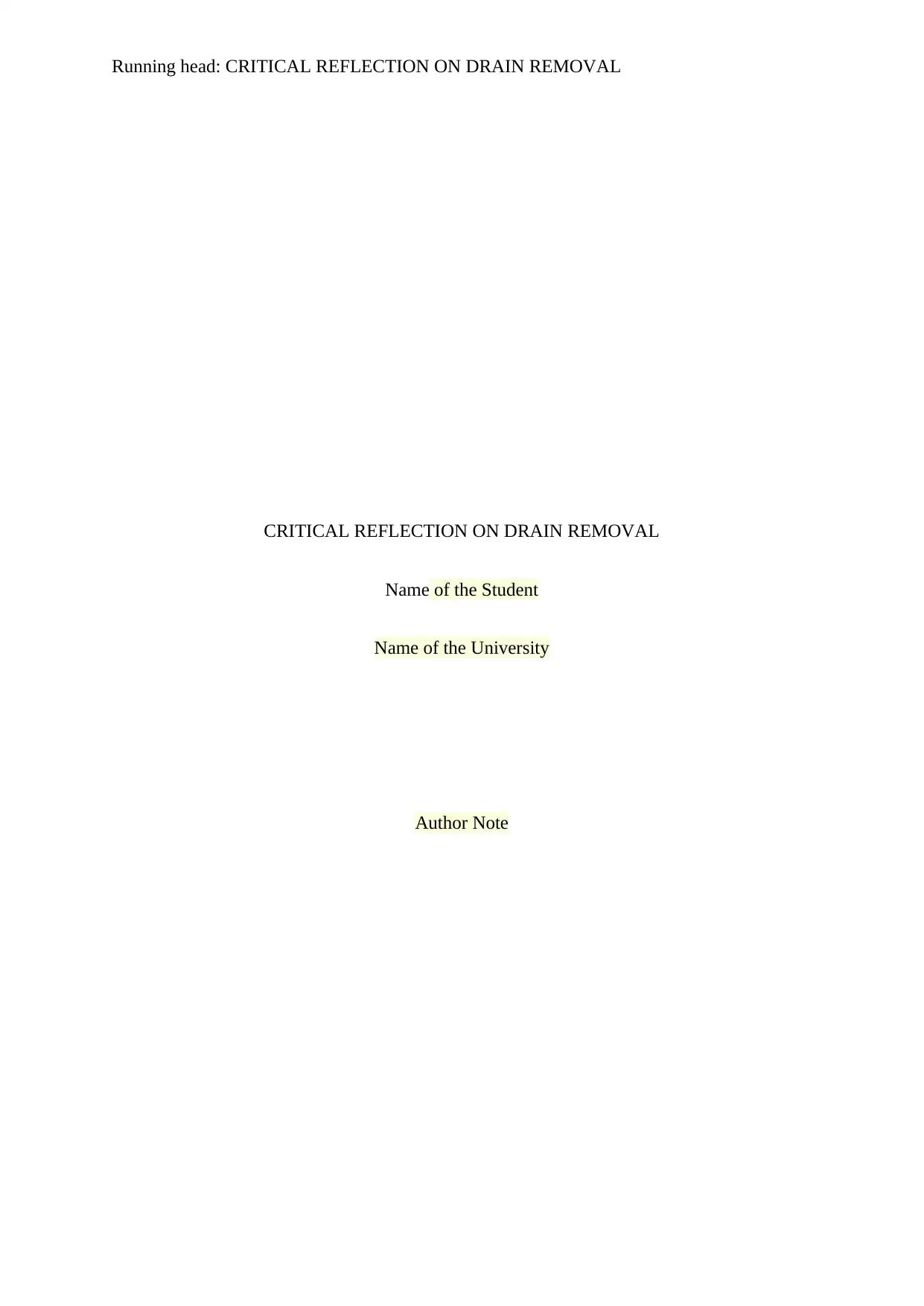
Running head: CRITICAL REFLECTION ON DRAIN REMOVAL
CRITICAL REFLECTION ON DRAIN REMOVAL
Name of the Student
Name of the University
Author Note
CRITICAL REFLECTION ON DRAIN REMOVAL
Name of the Student
Name of the University
Author Note
Paraphrase This Document
Need a fresh take? Get an instant paraphrase of this document with our AI Paraphraser
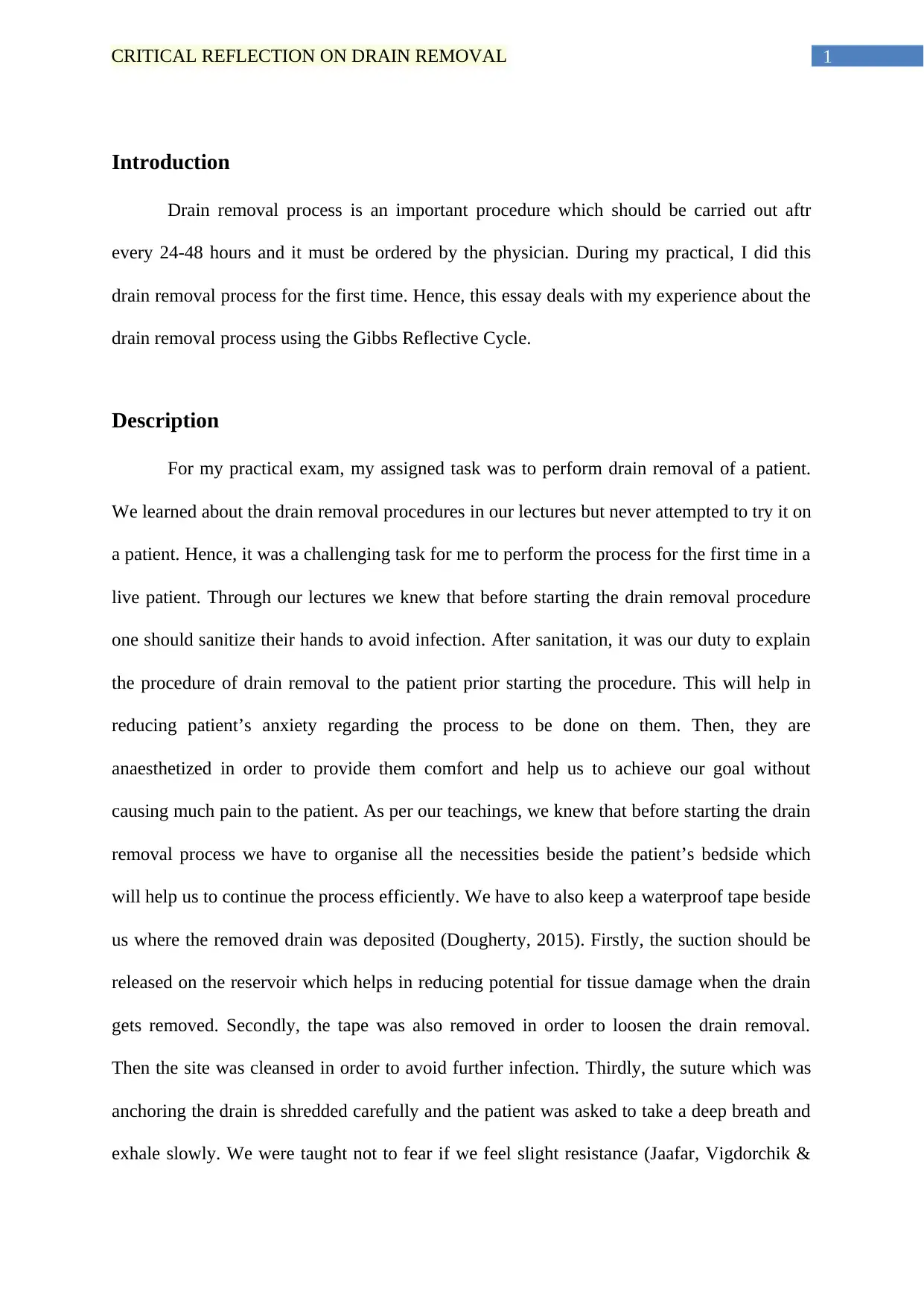
1CRITICAL REFLECTION ON DRAIN REMOVAL
Introduction
Drain removal process is an important procedure which should be carried out aftr
every 24-48 hours and it must be ordered by the physician. During my practical, I did this
drain removal process for the first time. Hence, this essay deals with my experience about the
drain removal process using the Gibbs Reflective Cycle.
Description
For my practical exam, my assigned task was to perform drain removal of a patient.
We learned about the drain removal procedures in our lectures but never attempted to try it on
a patient. Hence, it was a challenging task for me to perform the process for the first time in a
live patient. Through our lectures we knew that before starting the drain removal procedure
one should sanitize their hands to avoid infection. After sanitation, it was our duty to explain
the procedure of drain removal to the patient prior starting the procedure. This will help in
reducing patient’s anxiety regarding the process to be done on them. Then, they are
anaesthetized in order to provide them comfort and help us to achieve our goal without
causing much pain to the patient. As per our teachings, we knew that before starting the drain
removal process we have to organise all the necessities beside the patient’s bedside which
will help us to continue the process efficiently. We have to also keep a waterproof tape beside
us where the removed drain was deposited (Dougherty, 2015). Firstly, the suction should be
released on the reservoir which helps in reducing potential for tissue damage when the drain
gets removed. Secondly, the tape was also removed in order to loosen the drain removal.
Then the site was cleansed in order to avoid further infection. Thirdly, the suture which was
anchoring the drain is shredded carefully and the patient was asked to take a deep breath and
exhale slowly. We were taught not to fear if we feel slight resistance (Jaafar, Vigdorchik &
Introduction
Drain removal process is an important procedure which should be carried out aftr
every 24-48 hours and it must be ordered by the physician. During my practical, I did this
drain removal process for the first time. Hence, this essay deals with my experience about the
drain removal process using the Gibbs Reflective Cycle.
Description
For my practical exam, my assigned task was to perform drain removal of a patient.
We learned about the drain removal procedures in our lectures but never attempted to try it on
a patient. Hence, it was a challenging task for me to perform the process for the first time in a
live patient. Through our lectures we knew that before starting the drain removal procedure
one should sanitize their hands to avoid infection. After sanitation, it was our duty to explain
the procedure of drain removal to the patient prior starting the procedure. This will help in
reducing patient’s anxiety regarding the process to be done on them. Then, they are
anaesthetized in order to provide them comfort and help us to achieve our goal without
causing much pain to the patient. As per our teachings, we knew that before starting the drain
removal process we have to organise all the necessities beside the patient’s bedside which
will help us to continue the process efficiently. We have to also keep a waterproof tape beside
us where the removed drain was deposited (Dougherty, 2015). Firstly, the suction should be
released on the reservoir which helps in reducing potential for tissue damage when the drain
gets removed. Secondly, the tape was also removed in order to loosen the drain removal.
Then the site was cleansed in order to avoid further infection. Thirdly, the suture which was
anchoring the drain is shredded carefully and the patient was asked to take a deep breath and
exhale slowly. We were taught not to fear if we feel slight resistance (Jaafar, Vigdorchik &
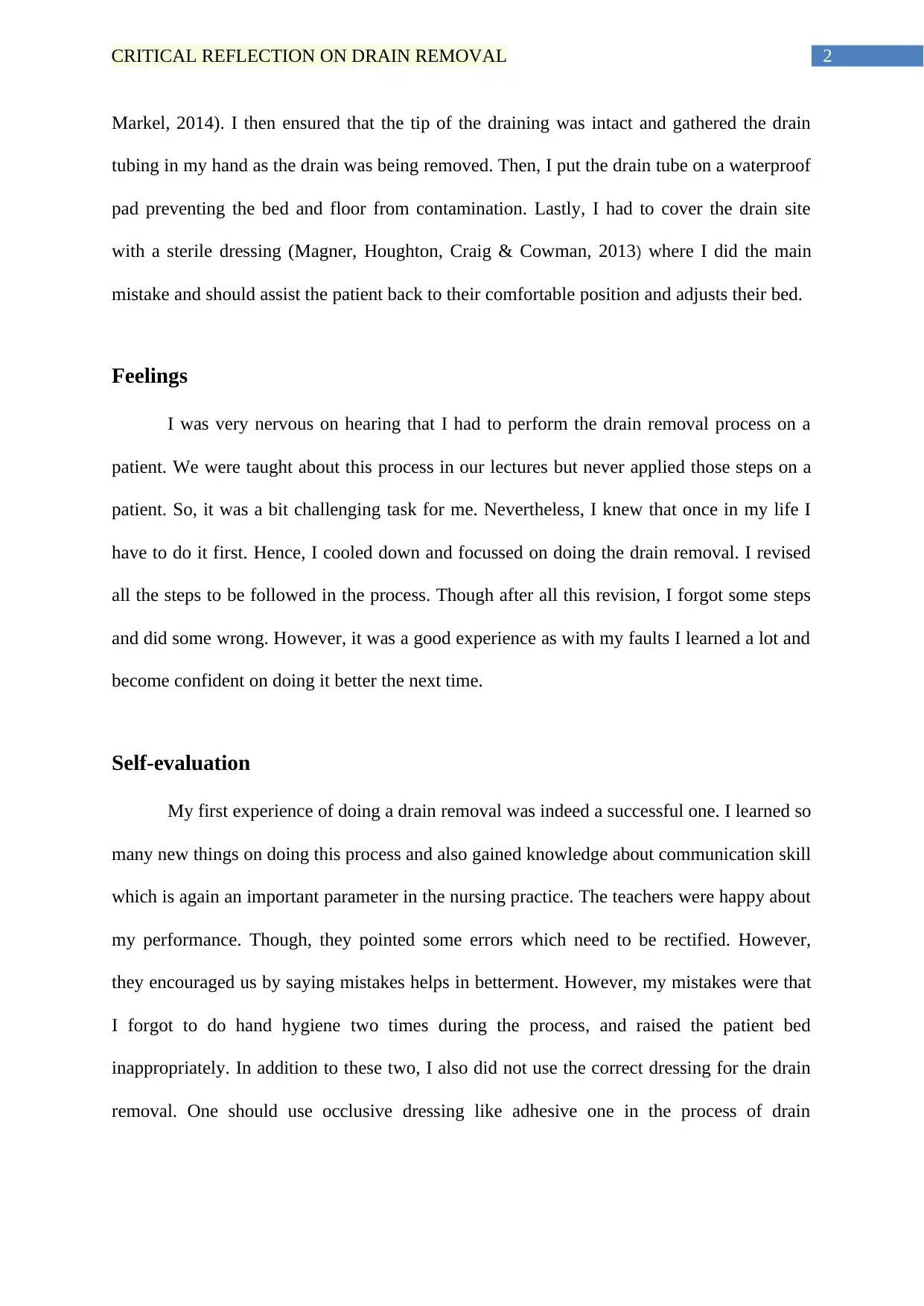
2CRITICAL REFLECTION ON DRAIN REMOVAL
Markel, 2014). I then ensured that the tip of the draining was intact and gathered the drain
tubing in my hand as the drain was being removed. Then, I put the drain tube on a waterproof
pad preventing the bed and floor from contamination. Lastly, I had to cover the drain site
with a sterile dressing (Magner, Houghton, Craig & Cowman, 2013) where I did the main
mistake and should assist the patient back to their comfortable position and adjusts their bed.
Feelings
I was very nervous on hearing that I had to perform the drain removal process on a
patient. We were taught about this process in our lectures but never applied those steps on a
patient. So, it was a bit challenging task for me. Nevertheless, I knew that once in my life I
have to do it first. Hence, I cooled down and focussed on doing the drain removal. I revised
all the steps to be followed in the process. Though after all this revision, I forgot some steps
and did some wrong. However, it was a good experience as with my faults I learned a lot and
become confident on doing it better the next time.
Self-evaluation
My first experience of doing a drain removal was indeed a successful one. I learned so
many new things on doing this process and also gained knowledge about communication skill
which is again an important parameter in the nursing practice. The teachers were happy about
my performance. Though, they pointed some errors which need to be rectified. However,
they encouraged us by saying mistakes helps in betterment. However, my mistakes were that
I forgot to do hand hygiene two times during the process, and raised the patient bed
inappropriately. In addition to these two, I also did not use the correct dressing for the drain
removal. One should use occlusive dressing like adhesive one in the process of drain
Markel, 2014). I then ensured that the tip of the draining was intact and gathered the drain
tubing in my hand as the drain was being removed. Then, I put the drain tube on a waterproof
pad preventing the bed and floor from contamination. Lastly, I had to cover the drain site
with a sterile dressing (Magner, Houghton, Craig & Cowman, 2013) where I did the main
mistake and should assist the patient back to their comfortable position and adjusts their bed.
Feelings
I was very nervous on hearing that I had to perform the drain removal process on a
patient. We were taught about this process in our lectures but never applied those steps on a
patient. So, it was a bit challenging task for me. Nevertheless, I knew that once in my life I
have to do it first. Hence, I cooled down and focussed on doing the drain removal. I revised
all the steps to be followed in the process. Though after all this revision, I forgot some steps
and did some wrong. However, it was a good experience as with my faults I learned a lot and
become confident on doing it better the next time.
Self-evaluation
My first experience of doing a drain removal was indeed a successful one. I learned so
many new things on doing this process and also gained knowledge about communication skill
which is again an important parameter in the nursing practice. The teachers were happy about
my performance. Though, they pointed some errors which need to be rectified. However,
they encouraged us by saying mistakes helps in betterment. However, my mistakes were that
I forgot to do hand hygiene two times during the process, and raised the patient bed
inappropriately. In addition to these two, I also did not use the correct dressing for the drain
removal. One should use occlusive dressing like adhesive one in the process of drain
⊘ This is a preview!⊘
Do you want full access?
Subscribe today to unlock all pages.

Trusted by 1+ million students worldwide
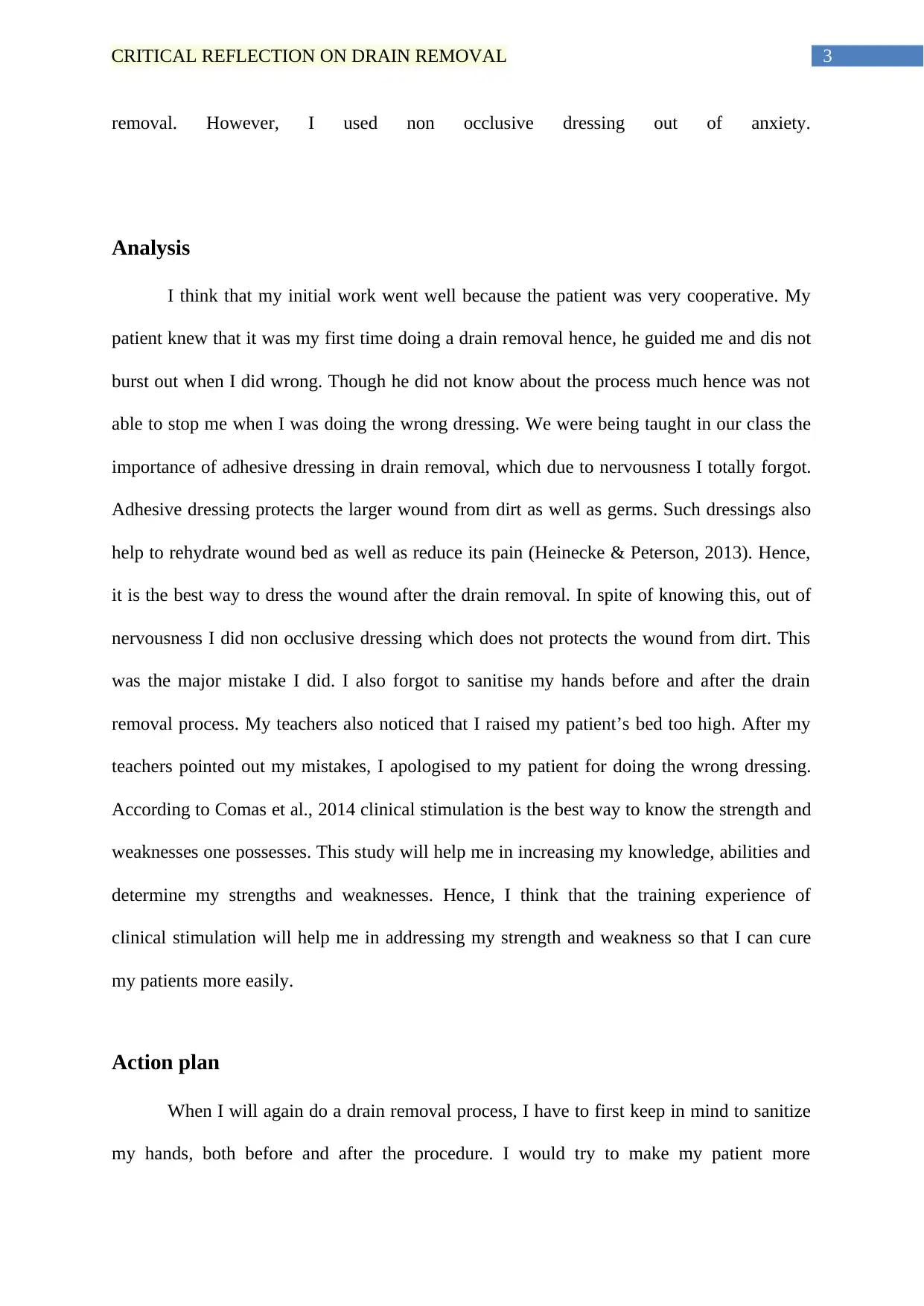
3CRITICAL REFLECTION ON DRAIN REMOVAL
removal. However, I used non occlusive dressing out of anxiety.
Analysis
I think that my initial work went well because the patient was very cooperative. My
patient knew that it was my first time doing a drain removal hence, he guided me and dis not
burst out when I did wrong. Though he did not know about the process much hence was not
able to stop me when I was doing the wrong dressing. We were being taught in our class the
importance of adhesive dressing in drain removal, which due to nervousness I totally forgot.
Adhesive dressing protects the larger wound from dirt as well as germs. Such dressings also
help to rehydrate wound bed as well as reduce its pain (Heinecke & Peterson, 2013). Hence,
it is the best way to dress the wound after the drain removal. In spite of knowing this, out of
nervousness I did non occlusive dressing which does not protects the wound from dirt. This
was the major mistake I did. I also forgot to sanitise my hands before and after the drain
removal process. My teachers also noticed that I raised my patient’s bed too high. After my
teachers pointed out my mistakes, I apologised to my patient for doing the wrong dressing.
According to Comas et al., 2014 clinical stimulation is the best way to know the strength and
weaknesses one possesses. This study will help me in increasing my knowledge, abilities and
determine my strengths and weaknesses. Hence, I think that the training experience of
clinical stimulation will help me in addressing my strength and weakness so that I can cure
my patients more easily.
Action plan
When I will again do a drain removal process, I have to first keep in mind to sanitize
my hands, both before and after the procedure. I would try to make my patient more
removal. However, I used non occlusive dressing out of anxiety.
Analysis
I think that my initial work went well because the patient was very cooperative. My
patient knew that it was my first time doing a drain removal hence, he guided me and dis not
burst out when I did wrong. Though he did not know about the process much hence was not
able to stop me when I was doing the wrong dressing. We were being taught in our class the
importance of adhesive dressing in drain removal, which due to nervousness I totally forgot.
Adhesive dressing protects the larger wound from dirt as well as germs. Such dressings also
help to rehydrate wound bed as well as reduce its pain (Heinecke & Peterson, 2013). Hence,
it is the best way to dress the wound after the drain removal. In spite of knowing this, out of
nervousness I did non occlusive dressing which does not protects the wound from dirt. This
was the major mistake I did. I also forgot to sanitise my hands before and after the drain
removal process. My teachers also noticed that I raised my patient’s bed too high. After my
teachers pointed out my mistakes, I apologised to my patient for doing the wrong dressing.
According to Comas et al., 2014 clinical stimulation is the best way to know the strength and
weaknesses one possesses. This study will help me in increasing my knowledge, abilities and
determine my strengths and weaknesses. Hence, I think that the training experience of
clinical stimulation will help me in addressing my strength and weakness so that I can cure
my patients more easily.
Action plan
When I will again do a drain removal process, I have to first keep in mind to sanitize
my hands, both before and after the procedure. I would try to make my patient more
Paraphrase This Document
Need a fresh take? Get an instant paraphrase of this document with our AI Paraphraser
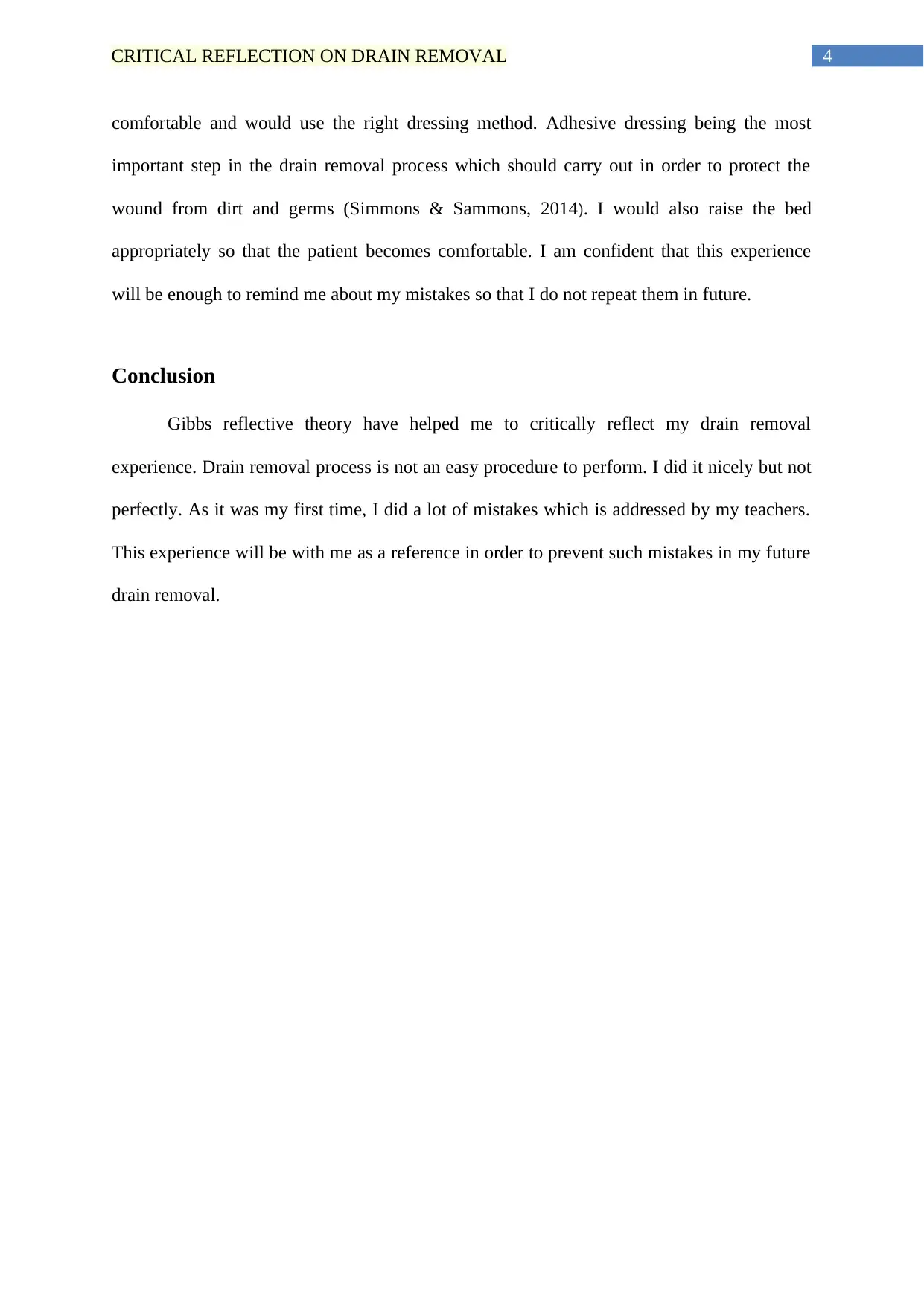
4CRITICAL REFLECTION ON DRAIN REMOVAL
comfortable and would use the right dressing method. Adhesive dressing being the most
important step in the drain removal process which should carry out in order to protect the
wound from dirt and germs (Simmons & Sammons, 2014). I would also raise the bed
appropriately so that the patient becomes comfortable. I am confident that this experience
will be enough to remind me about my mistakes so that I do not repeat them in future.
Conclusion
Gibbs reflective theory have helped me to critically reflect my drain removal
experience. Drain removal process is not an easy procedure to perform. I did it nicely but not
perfectly. As it was my first time, I did a lot of mistakes which is addressed by my teachers.
This experience will be with me as a reference in order to prevent such mistakes in my future
drain removal.
comfortable and would use the right dressing method. Adhesive dressing being the most
important step in the drain removal process which should carry out in order to protect the
wound from dirt and germs (Simmons & Sammons, 2014). I would also raise the bed
appropriately so that the patient becomes comfortable. I am confident that this experience
will be enough to remind me about my mistakes so that I do not repeat them in future.
Conclusion
Gibbs reflective theory have helped me to critically reflect my drain removal
experience. Drain removal process is not an easy procedure to perform. I did it nicely but not
perfectly. As it was my first time, I did a lot of mistakes which is addressed by my teachers.
This experience will be with me as a reference in order to prevent such mistakes in my future
drain removal.
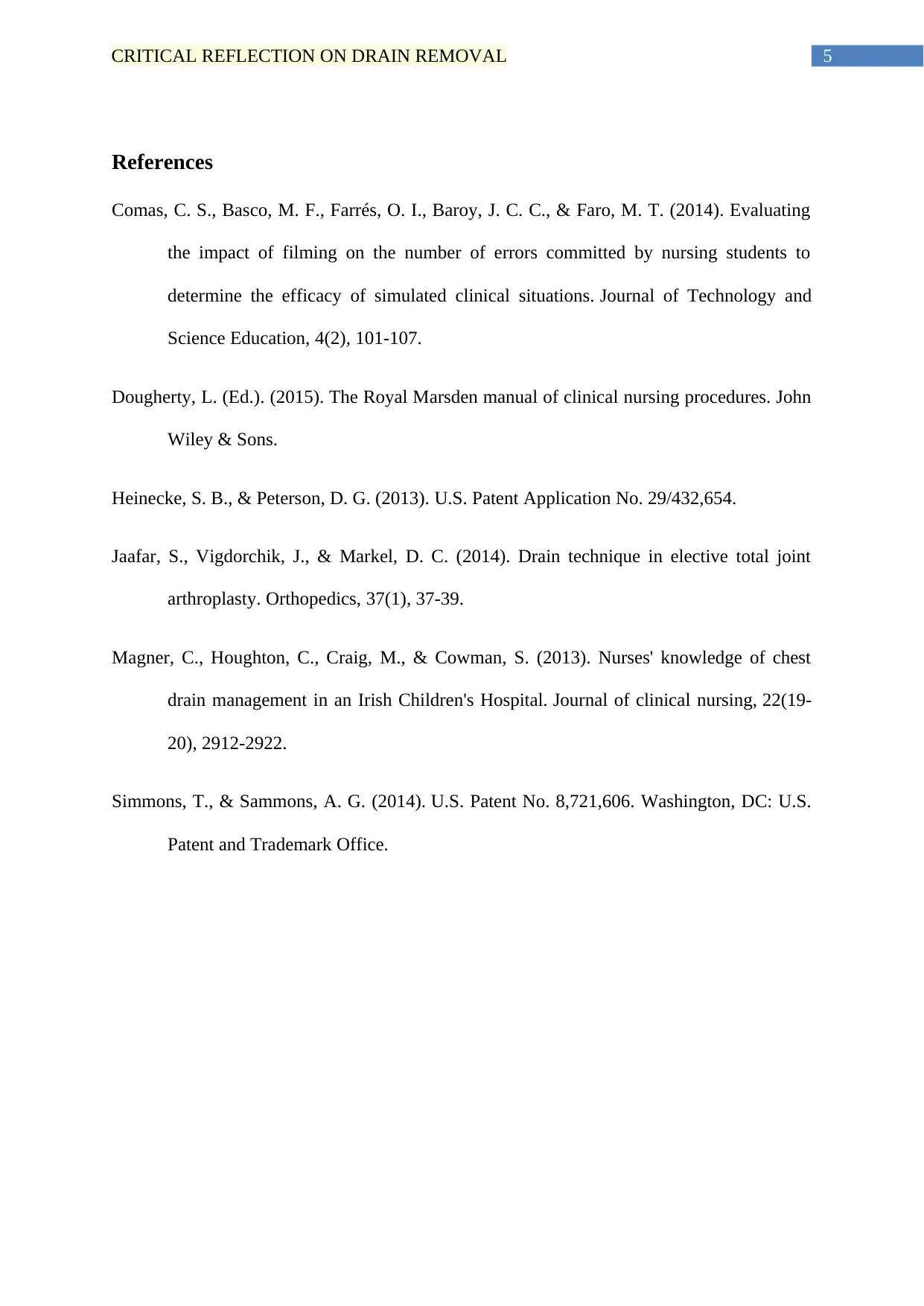
5CRITICAL REFLECTION ON DRAIN REMOVAL
References
Comas, C. S., Basco, M. F., Farrés, O. I., Baroy, J. C. C., & Faro, M. T. (2014). Evaluating
the impact of filming on the number of errors committed by nursing students to
determine the efficacy of simulated clinical situations. Journal of Technology and
Science Education, 4(2), 101-107.
Dougherty, L. (Ed.). (2015). The Royal Marsden manual of clinical nursing procedures. John
Wiley & Sons.
Heinecke, S. B., & Peterson, D. G. (2013). U.S. Patent Application No. 29/432,654.
Jaafar, S., Vigdorchik, J., & Markel, D. C. (2014). Drain technique in elective total joint
arthroplasty. Orthopedics, 37(1), 37-39.
Magner, C., Houghton, C., Craig, M., & Cowman, S. (2013). Nurses' knowledge of chest
drain management in an Irish Children's Hospital. Journal of clinical nursing, 22(19-
20), 2912-2922.
Simmons, T., & Sammons, A. G. (2014). U.S. Patent No. 8,721,606. Washington, DC: U.S.
Patent and Trademark Office.
References
Comas, C. S., Basco, M. F., Farrés, O. I., Baroy, J. C. C., & Faro, M. T. (2014). Evaluating
the impact of filming on the number of errors committed by nursing students to
determine the efficacy of simulated clinical situations. Journal of Technology and
Science Education, 4(2), 101-107.
Dougherty, L. (Ed.). (2015). The Royal Marsden manual of clinical nursing procedures. John
Wiley & Sons.
Heinecke, S. B., & Peterson, D. G. (2013). U.S. Patent Application No. 29/432,654.
Jaafar, S., Vigdorchik, J., & Markel, D. C. (2014). Drain technique in elective total joint
arthroplasty. Orthopedics, 37(1), 37-39.
Magner, C., Houghton, C., Craig, M., & Cowman, S. (2013). Nurses' knowledge of chest
drain management in an Irish Children's Hospital. Journal of clinical nursing, 22(19-
20), 2912-2922.
Simmons, T., & Sammons, A. G. (2014). U.S. Patent No. 8,721,606. Washington, DC: U.S.
Patent and Trademark Office.
⊘ This is a preview!⊘
Do you want full access?
Subscribe today to unlock all pages.

Trusted by 1+ million students worldwide
1 out of 6
Related Documents
Your All-in-One AI-Powered Toolkit for Academic Success.
+13062052269
info@desklib.com
Available 24*7 on WhatsApp / Email
![[object Object]](/_next/static/media/star-bottom.7253800d.svg)
Unlock your academic potential
Copyright © 2020–2025 A2Z Services. All Rights Reserved. Developed and managed by ZUCOL.



